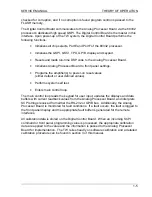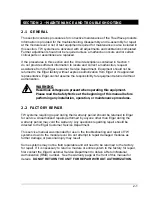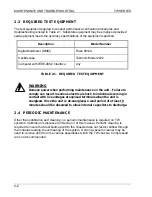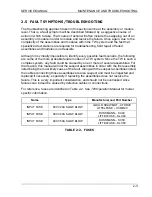
SERVICE MANUAL
THEORY OF OPERATION
1-9
The PFC module is a two–board assembly consisting of a PFC Power and a PFC
Control board. The single–phase AC input voltage enters the PFC power board where it
is rectified by the full-wave bridge rectifier circuit, developing a raw 380 Vdc bus. The
raw 380 Vdc bus is then delivered through a soft–start relay to the PFC circuit, which is
comprised of a boost converter. The output of the PFC, a regulated 380 Vdc bus, is
then delivered to the DC/DC stage of the power module. The 380 Vdc bus is also
converted down to a 24 Vdc bus used to power the control circuitry for the PFC power
and control boards.
CAUTION
When the PFC module is configured for the INTERNATIONAL input
configuration, the input neutral must be connected. Failure to do so
will result in catastrophic damage to the PFC input.
1.7.3 DC/DC CONVERTER
The DC/DC converter module, or just DC/DC, is a two–board assembly consisting of a
DC/DC Converter Power and a DC/DC Converter Control board. The DC/DC serves two
purposes. First, to provide isolation between the 3 phase input voltage and the eventual
output voltage used by the customer. Second, to generate the two isolated 290 Vdc
buses used by the amplifier and a 48 Vdc bus used by the HSKP board and fan panel
assembly. The DC/DC converter circuit is rated for 2000 watts and consists of a PWM
controlled full H-bridge, which chops (switches) the 380 Vdc bus supplied by the
rectifier or PFC input stage at a rate of 140 kHz. The output transformer and three full-
wave bridge rectifier circuits then generate the two 290 Vdc and 48 Vdc buses. The
output transformer and associated rectifier circuitry also produces a 27 Vdc bus which
provides power for the DC/DC PWM control circuit.
1.8 AMPLIFIER MODULE
The amplifier module is a four board assembly consisting of an Amplifier Power, an
Amplifier Control and two Gate Drive boards. The amplifier module is in fact comprised
of two 156 V / 6.5 A amplifiers (upper and lower) which can be series or paralleled by
relay K1 on the Amplifier Power board to produce a single 312 V / 6.5 A or 156 V / 13 A
output. Relay K2 is the amplifier output relay but breaks only the line connection to the
output filter and not the neutral. The drive circuits for K1 and K2 are located on the
amplifier control board and respond to commands from the Analog board. Both the
upper and lower amplifiers consist of identical full H-bridges that vary only in the
method in which the bridge current is measured. The lower bridge uses a shunt resistor
to monitor the bridge current while the upper bridge uses a hall-effect current
transformer to provide isolation.
The amplifier control board contains the PWM circuit that generates the drive
waveforms to the upper and lower H-bridges from the input voltage reference signal
sent by the Analog board and the current feedback signals from the upper and lower
bridges. The amplifier runs at a frequency of 200 kHz, interleaved, which equates to an
Summary of Contents for TrueWave TW5250
Page 2: ......
Page 4: ...ii This page intentionally left blank...
Page 10: ...TABLE OF CONTENTS TW SERIES viii This page intentionally left blank...
Page 36: ...MAINTENANCE AND TROUBLESHOOTING TW SERIES 2 16 This page intentionally left blank...
Page 80: ...CALIBRATION TW SERIES 3 44 This page intentionally left blank...
















































